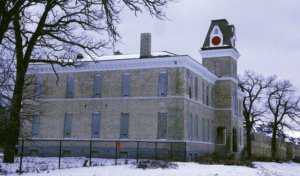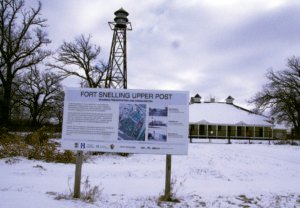(Concept illustration provided)
By TESHA M. CHRISTENSEN
Nearly 160 years after their construction, the brick buildings at the Upper Fort Snelling Post will once again house military families.
Vacant and abandoned for decades, 26 buildings are being renovated through a partnership with the Minnesota Department of Natural Resources (DNR) and a private development firm, Dominium.
“We’re excited to be focusing on housing low-income veterans at this site by having a veteran’s preference,” pointed out Mark C. Lambing of Dominium.
“By having a high count of three- and four-bedroom units, we believe that the redevelopment is going to attract families with children. Because the site is located on 47 acres and contains a large amount of green space, it will be a great place to raise a family. Upper Post Flats will feel more like a neighborhood than an apartment complex.”
 Photo right: The Upper Post was once the military capital of the Dakotas, and George Armstrong Custer’s superior officer commanded there for a time. It served the armed forces from the Spanish American War until after the dropping of the atomic bomb. It was also home to the Japanese Language School for the entire U.S. military during World War II. (Photo by Tesha M. Christensen)
Photo right: The Upper Post was once the military capital of the Dakotas, and George Armstrong Custer’s superior officer commanded there for a time. It served the armed forces from the Spanish American War until after the dropping of the atomic bomb. It was also home to the Japanese Language School for the entire U.S. military during World War II. (Photo by Tesha M. Christensen)
In all, about 176 units of affordable housing will be created in the historic buildings at the Fort Snelling Upper Post, near the Fort Snelling Golf Course and Historic Fort Snelling. The development is tucked into a corner of the last unincorporated part of Hennepin County bordered by Hwys 62 and 5 and the airport.
Fills affordable housing need
“This is an outstanding example of a public-private partnership with important benefits for Minnesotans,” said Gov. Mark Dayton in a release issued by his office. “It comes at a time when there is a great need for affordable housing.”
A report by the Governor’s Task Force on Housing, published in August, called for the creation of 300,000 new affordable housing units by 2030.
Rents will be restricted to residents who make 60% of the area median income and below. Currently, those rents range from around $1,000 a month for a one-bedroom apartment to around $1,500 a month for a four-bedroom duplex.
 Photo left: In all, about 176 units of affordable housing will be created in the historic buildings at the Fort Snelling Upper Post, near the Fort Snelling Golf Course and Historic Fort Snelling. The development is tucked into a corner of the last unincorporated part of Hennepin County bordered by Hwys 62 and 5 and the airport. (Photo by Tesha M. Christensen)
Photo left: In all, about 176 units of affordable housing will be created in the historic buildings at the Fort Snelling Upper Post, near the Fort Snelling Golf Course and Historic Fort Snelling. The development is tucked into a corner of the last unincorporated part of Hennepin County bordered by Hwys 62 and 5 and the airport. (Photo by Tesha M. Christensen)
“There’s a great need for affordable housing throughout the metro area in general,” stated Lambing. “The Met Council found that only 1 in 7 units of housing created in the region during 2016 were affordable for those that make 60% of the area median income. The site’s proximity to the Fort Snelling Light Rail Station provides access to large employment hubs such as downtown Minneapolis, MSP Airport, and The Mall of America. The easy highway access also offers convenience to those that commute by car.”
To open in 2021
Upper Post Flats is expected to open to its first residents in 2021, and units will be available for rent on a rolling basis as the buildings are complete, pointed out Lambing.
The project will be segmented into multiple zones that will be worked on concurrently by the various trades.
The $100 million project is being financed through a combination of Low-Income Housing Tax Credits, Federal and State Historic Tax Credits, tax-exempt bonds through Hennepin County, and other sources.
About half of the project bill will go towards historic preservation.
 Photo right: Vacant and abandoned for decades, 26 buildings are being renovated through a partnership with the Minnesota Department of Natural Resources (DNR) and a private development firm, Dominium. Veterans will receive priority in these affordable housing units. (Photo by Tesha M. Christensen)
Photo right: Vacant and abandoned for decades, 26 buildings are being renovated through a partnership with the Minnesota Department of Natural Resources (DNR) and a private development firm, Dominium. Veterans will receive priority in these affordable housing units. (Photo by Tesha M. Christensen)
The first step is to assess all 26 buildings to identify elements of historical significance. At the same time, Dominium is evaluating the current state and structural integrity of the buildings so that its construction scope is accurate.
“Next is figuring out how to fit apartments into buildings that were built for other purposes, which can be tricky and time-consuming,” explained Lambing. “Then you have to abate the asbestos and lead-based paint throughout the site to make sure that there is nothing is hazardous to future residents.”
Lambing added, “After this, it’s a matter of implementing the new design through the construction process while dealing with all the unforeseen issues that might arise—which is typical for a project of this nature.”
Next steps will include finalizing the design and seeking approval from the Minnesota State Historic Preservation Office. Dominium expects to close on financing by late summer or early fall 2019.
Under the agreement, the state of Minnesota retains ownership of the site, but all management and operation of the buildings and site amenities will be Dominium’s responsibility per a 99-year lease.
An important part of history
“The buildings are an important part of Minnesota’s and the U.S. Military’s history,” remarked Lambing. “The history of the site, in addition to the craftsmanship used to construct these buildings, make it irreplaceable and deserving to be saved.”
 Photo left: The infantry quarters of Fort Snelling Upper Post, 1908. (Photo provided)
Photo left: The infantry quarters of Fort Snelling Upper Post, 1908. (Photo provided)
Beyond the visible history, the archaeology on site is also an important element to consider, observed Lambing. “Because of the age of the site, the ground has kept a record of all the activity that has taken place. We have to be much more aware of what we’re doing to the ground than a typical new construction project.” Dominium will work with archaeologists to document what is hidden in the soil and better understand potential impacts that construction might have on the site.
In 2006, the Upper Post was named to the National Trust for Historic Preservation’s Most Endangered Places list.
The Upper Post was once the military capital of the Dakotas, and George Armstrong Custer’s superior officer commanded there for a time. It served the armed forces from the Spanish American War until after the dropping of the atomic bomb. It was also home to the Japanese Language School for the entire U.S. military during World War II.
The land was transferred from the military to the VA and then to the DNR in the 1970s.
Vacant and boarded up for decades
The buildings were in rough shape, and one fell down ten years ago. Hennepin County Commissioner District 4 Peter McLaughlin, chair of the Fort Snelling Upper Post Task Force, recalled bringing Sentence-To-Service crews out to stabilize the structures by boarding up windows, fixing roofs, and repairing downspouts.
Patrick Connoy, retired manager of development for Hennepin County, pointed out that many people and organizations came together over the years to provide stopgap measures to prevent additional decay while waiting for someone to rehabilitate the buildings for a new use. Among those were the Friends of Fort Snelling, the Minnesota Historical Society, Preservation Alliance of Minnesota, National Park Service, DNR, and more, with Hennepin County taking the lead to pull resources and people together.
“Everybody helped as much as they could,” observed Connoy. “‘They’ in this case was a lot of people committed to doing something and working together.”
In 2011, the county also began working with others to create a plan for redevelopment, Light Rail Transit, and Upper Post master plan.
While the condition of the buildings is a challenge for development, with structures ranging from pretty good to collapsed, Dominium has a top team of architects and construction professionals. “We’re confident in our ability to breathe life back into the site,” said Lambing.
Past Dominium projects have included Schmidt Brewery on W. Seventh St. in St. Paul, the Pillsbury A-Mill in Minneapolis, Millworks Lofts at 4041 Hiawatha Ave. in Longfellow, and other historic landmarks.
‘Can hardly wait’
“The DNR is pleased to be working with Dominium on this redevelopment project, and we can hardly wait to see these beautiful old buildings occupied again after standing empty for so long,” said DNR Commissioner Tom Landwehr.
“We’d like to thank the DNR for their help in getting this project one step closer to fruition,” said Lambing. “Without this close public-private partnership this project would not be possible.”
Anyone interested in living at the Upper Post can visit Upperpostflats.com to join the insider’s list.
Comments
No comments on this item Please log in to comment by clicking here